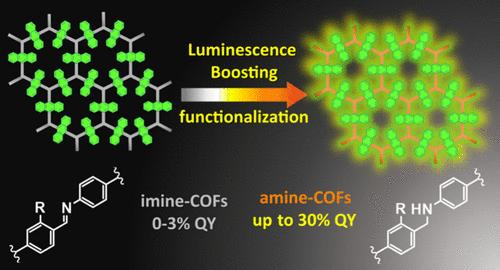亚胺共价有机框架的还原转化为发射聚合物:对发射猝灭的见解
IF 7
2区 材料科学
Q2 CHEMISTRY, PHYSICAL
引用次数: 0
摘要
虽然亚胺连接的共价有机框架(COFs)很容易合成,但它们缺乏本然发射限制了它们在光电应用中的潜力。此外,控制激发态能量耗散的潜在机制仍然知之甚少。为了克服这些限制,我们提出了一种直接的策略,通过NaBH3CN/苯甲酸还原将非发射的蒽基亚胺- cofs (im-COF)转化为高发射的胺基共价有机聚合物(am-COP),实现固态发射量子产率高达30%。为了阐明COFs和cop的激发态能量耗散机制,我们合成了具有亚胺或胺功能的分子参考化合物。光物理研究在密度泛函理论(DFT)计算的支持下,揭示了胺和亚胺的激发态都表现出弱电荷转移(CT)性质。此外,对参考分子、im-COFs和am- cop的光物理行为的比较分析表明,电荷转移过程中产生的聚合物发射受到聚合物固有极性的调节。这些发现为COFs的光物理行为提供了基本的见解,从而为开发具有先进应用前景的发射多孔材料铺平了道路。本文章由计算机程序翻译,如有差异,请以英文原文为准。

Reductive Transformation of Imine Covalent Organic Frameworks into Emissive Polymers: Insights into Emission Quenching
Although imine-linked covalent organic frameworks (COFs) are readily synthesized, their lack of intrinsic emission constrains their potential in optoelectronic applications. Moreover, the underlying mechanisms governing excited-state energy dissipation remain poorly understood. To overcome these limitations, we present a straightforward strategy to transform nonemissive, anthracene-based imine-COFs (im-COF) into highly emissive amine-based covalent organic polymers (am-COP) through NaBH3CN/benzoic acid reduction, achieving solid-state emission quantum yields of up to 30%. To clarify the excited-state energy dissipation mechanisms in COFs and COPs, we synthesized molecular reference compounds featuring either imine or amine functionalities. Photophysical studies, supported by density functional theory (DFT) calculations, reveal that the excited states of both amines and imines exhibit weak charge transfer (CT) properties. Furthermore, a comparative analysis of the photophysical behavior of molecular references, im-COFs, and am-COPs demonstrates that the polymer emission arising from charge-transfer processes is modulated by the polymer’s intrinsic polarity. These findings provide fundamental insights into the photophysical behavior of COFs, thus paving the way for the development of emissive porous materials with promising advanced applications.
求助全文
通过发布文献求助,成功后即可免费获取论文全文。
去求助
来源期刊

Chemistry of Materials
工程技术-材料科学:综合
CiteScore
14.10
自引率
5.80%
发文量
929
审稿时长
1.5 months
期刊介绍:
The journal Chemistry of Materials focuses on publishing original research at the intersection of materials science and chemistry. The studies published in the journal involve chemistry as a prominent component and explore topics such as the design, synthesis, characterization, processing, understanding, and application of functional or potentially functional materials. The journal covers various areas of interest, including inorganic and organic solid-state chemistry, nanomaterials, biomaterials, thin films and polymers, and composite/hybrid materials. The journal particularly seeks papers that highlight the creation or development of innovative materials with novel optical, electrical, magnetic, catalytic, or mechanical properties. It is essential that manuscripts on these topics have a primary focus on the chemistry of materials and represent a significant advancement compared to prior research. Before external reviews are sought, submitted manuscripts undergo a review process by a minimum of two editors to ensure their appropriateness for the journal and the presence of sufficient evidence of a significant advance that will be of broad interest to the materials chemistry community.
 求助内容:
求助内容: 应助结果提醒方式:
应助结果提醒方式:


